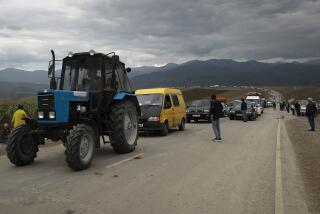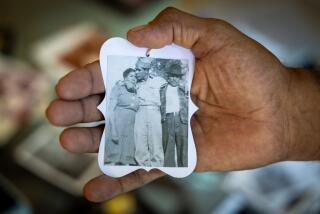Armenian Community and Soviet Quake Victims Linked in Sorrow
As other Armenians huddled in tight, worried little groups, passing along rare nuggets of information about the situation in their earthquake-devastated homeland, the woman in the Pasadena butcher shop spoke bluntly. A few bleak words were all she needed to recount what she knew of her own family in Armenia.
“We talk to one relative in Yerevan,” said Mary Bidinian in broken English, her eyes looking straight into the questioner’s face. “He’s alive. The others in Leninakan and Kirovakan? We have not heard. Maybe they dead.”
There is a process to these things, many San Gabriel Valley Armenians suggested last week as the casualty figures mounted. If you are a member of an oppressed Soviet minority with a long history of disaster, you first find out who’s alive and who’s dead. Then you mourn the dead and do what you can to comfort the living.
That’s precisely what was going on last week in the region’s tight-knit Armenian community, about 15,000 concentrated in Pasadena and several thousand more scattered throughout the San Gabriel Valley. They mourned an estimated 60,000 dead--blood relatives in some cases, but often just fellow members of what one leader called “the Armenian family”--and worked to succor the survivors.
The latest thunderbolt of misfortune also prompted many Armenians to probe once again, like a man running his fingers over a recently healed wound, the sense of troubled destiny out of which has come their national identity.
“Mourning is part of our lives,” said Krikor Mesrobian, a Pasadena caterer who was leading fund-raising efforts at the Pasadena Armenian Center on Washington Boulevard.
Mesrobian recited the list of 20th-Century events that Armenians mourn: genocidal attacks by Turkey, despotic rule by the Soviet Union, partition of the little nation by its more powerful neighbors and, finally, doors slammed by Middle Eastern nations in the faces of Armenian refugees.
“And now this,” said Mesrobian, raising his hands in an age-old gesture of bewilderment. “It’s amazing. How come so much?”
Others were asking the same question, but no one waited for an answer. Most were pitching in energetically to send relief to the homeland. For example, at the Pasadena Armenian Center on Tuesday, volunteers loaded large sacks full of donated clothes and blankets into trucks as community members marched in with cash donations. There was talk of large gifts and small ones.
“The other day a couple came in with tears in their eyes,” said Seta Torossian, who was manning a desk for the Armenian Revolutionary Federation, one of the half dozen agencies that maintain offices in the center. “The lady said, ‘I’m on welfare, and nobody in the family is working.’ She gave me the money she held in her hand. ‘This money goes to earthquake relief,’ she said. ‘We eat no meat this month.’ ”
According to Mesrobian, the office had raised $35,000 in the first three days.
In Altadena, at the Sahag-Mesrob Armenian Christian School, one of two Armenian schools in the region, children have set a goal of raising $5,000 among themselves. “Today I brought in all of the money from my piggy bank,” said fifth-grader Sarine Avedikian, 10. She said her $25 donation was what she had saved for three years to buy Christmas presents.
“I decided to give it to Armenia so they could build houses,” she said.
By Wednesday, the class of fifth-grade teacher Alice Mazmanian had raised $300.
In the heart of the Armenian business district, on Washington Boulevard between Hill and Allen avenues, merchants passed around donation boxes and talked of establishing a blood bank for earthquake victims. “A lot of people want to donate blood,” said Krikor Kederian, owner of Champion Cleaners. “We want to put a blood station up somewhere, but the Red Cross said there is no demand yet.”
Like many others, Kederian’s face had a haunted, insomniac look last week. “We feel very bad about this, even guilty,” he said earnestly. “We are very comfortable here in America, while we know people are suffering over there.”
The words could have described Pasadena’s Armenian community long before the earthquake brought last week’s fraternal outpouring. In the past 15 years or so, Armenian refugees from the Middle East have settled in the city in large numbers and established a solid commercial base in the shops on Washington Boulevard. They have also achieved unprecedented political acceptance by the city, whose mountainous backdrop reminds many Armenians of their native Caucasus.
First, the city extended affirmative action protection to Armenians in 1985, giving them a special protective status in awarding city contracts and recruiting for city jobs. Then, in May, 1987, voters elected an Armenian, William Paparian, to the Pasadena Board of Directors.
“They’ve made room for us in this city,” said Mesrobian. “It’s something we’ll never forget.”
Nevertheless, most American Armenians never get so comfortable that they forget the continuing plight of Armenians in the Middle East and Asia Minor, said Paparian. Their abiding ties to the old country stem from its 20th-Century afflictions, he said, particularly the annihilation of as many as 1.5 million Armenians by the Turks between 1915 and 1920.
A bonding has occurred because of that historical experience, said Paparian. “My earliest memory as a little kid was waking up one night and finding my mother with tears coming down her cheeks,” Paparian said. “She said, ‘You’ll never understand what happened to our family.’ ”
Armenians often speak of “the genocide” as the dominating element in their national identity. It has given Armenians, even those who are three or four generations removed from the homeland, a sense of vulnerability and protectiveness, said Mesrobian.
“Our culture is like a beautiful rose,” he said. “Something beautiful like that will fade away if it’s not kept up.”
But Andre Barsoumian, a music teacher at Pasadena High School who once served as music director of the American University in Beirut, Lebanon, said the bonding between far-flung Armenians also was related to their experiences in the Middle Eastern countries where many fled after World War I to compete with other national groups for patches of territory.
“In the Middle East, you’re constantly reminded that your homeland is really Armenia,” he said.
As in other cities where Armenians have congregated, the Pasadena community has sought to re-create a bit of the homeland abroad. On Washington Boulevard, the grocery stores bristle with fragrant Middle Eastern products.
“I’ve never been to Armenia, but we all have Armenian blood,” said Mary Donikian, whose family owns the American Armenian Grocery. The store’s shelves are stocked with, among other things, pistachios, almonds, garbanzo beans, jarred yogurt curds in oil and a dozen different kinds of olive oil, while long, thin salami dangle from the ceiling.
Among the women who gathered in the store on Tuesday was Elizabeth Oghanesyan, who arrived in Pasadena from Soviet Armenia just a year ago. Her 13-year-old son, Akop, she said, had just learned that his entire class of former schoolmates in Kirovakan had been killed.
“My son is cry, cry, cry,” she said.
At the Sahag-Mesrob School, in the foothills above Pasadena, 250 impeccably behaved school children in uniforms learn, among many other things, the Armenian alphabet and the troubled history of their forefathers. It’s part of that bonding that Paparian and others talked about, says Jack Loussararian, whose school is accredited by the state to teach children from kindergarten to the eighth grade.
“Armenians have always been very close to the fatherland,” he said. “Parents like to have their children learn Armenian and to grow up in a Christian atmosphere.”
In a literal sense, the closest that an American Armenian will be able to get to his homeland will soon be in La Verne, about 20 miles east of Pasadena, on the campus of the American Armenian International College.
Native Stone
The 12-year-old college, the only one of its kind in the Western Hemisphere, has literally transported a large chunk of the homeland to the San Gabriel Valley. The school has acquired almost 50 tons of the native Armenian stone called touf. The pinkish material, used for centuries in buildings in Yerevan, Armenia’s capital, will become the facade of the college’s new academic center, said Garbis Der Yeghiayan, president of the school.
“We expect to go into construction in March,” said Der Yeghiayan, who is also chairman of the Intercommunity Relief Fund, formed a week ago by a coalition of Armenian groups to lead the earthquake relief effort.
Not everyone in the Armenian community shares the prosperity of second- or third-generation professionals like Paparian or even of the shop owners on Washington Boulevard.
Recent arrivals from the Soviet Union have particular difficulties, said Suzanne Berberian, a social worker for the Armenian Relief Society, which has been awarded a federal grant to provide assistance to refugees.
“Many are good technicians, but they have a language barrier,” she said. She described a man who had worked as a choirmaster in Armenia. “He ended up working as an assembly worker in Anaheim for $5.50 an hour,” said Berberian. “Then he was laid off. He has a music brain, but there’s no way for him to be a part of American music society. He ends up doing assembly work, and it hurts him.”
Differences Transcended
There is a tradition of friction between the haves and the have-nots, most Armenians acknowledge. “The generation that grew up in the United States has a different perception of things by virtue of the fact that they were born here,” says Paparian. “There has been a perception on the part of some from Armenia that those of us on this side are less patriotic because we don’t speak Armenian every day in conversation or listen to Armenian music when we go to social events. I think that’s a misconception.”
If there is a silver lining to the disaster in Armenia, some Armenians said, it is that it has swept away such petty differences. “There has always been fragmentation,” said Glendale immigration attorney Vartkes Yeghiyan. “What the natural disaster has done is to cause all people to coalesce, to work together.”
At schools and churches, as well as in neighborhoods such as Upper Hastings Ranch, where many Armenians have settled, the tone for the Christmas season this year will be more somber than usual. Many Armenians have elected not to participate in the elaborate display of home Christmas lights, said Burt Garavaglia, president of the Upper Hastings Ranch Assn.
“Some have told us that out of respect for the homeland, they’re observing a moratorium on displaying lights,” he said.
Others told of dismantling their Christmas trees when word of the earthquake arrived and turning over their Christmas funds to relief agencies.
Such gestures were spontaneous, said Mesrobian. “On an occasion like this, you don’t have to organize things like that,” he said.
More to Read
Sign up for Essential California
The most important California stories and recommendations in your inbox every morning.
You may occasionally receive promotional content from the Los Angeles Times.










